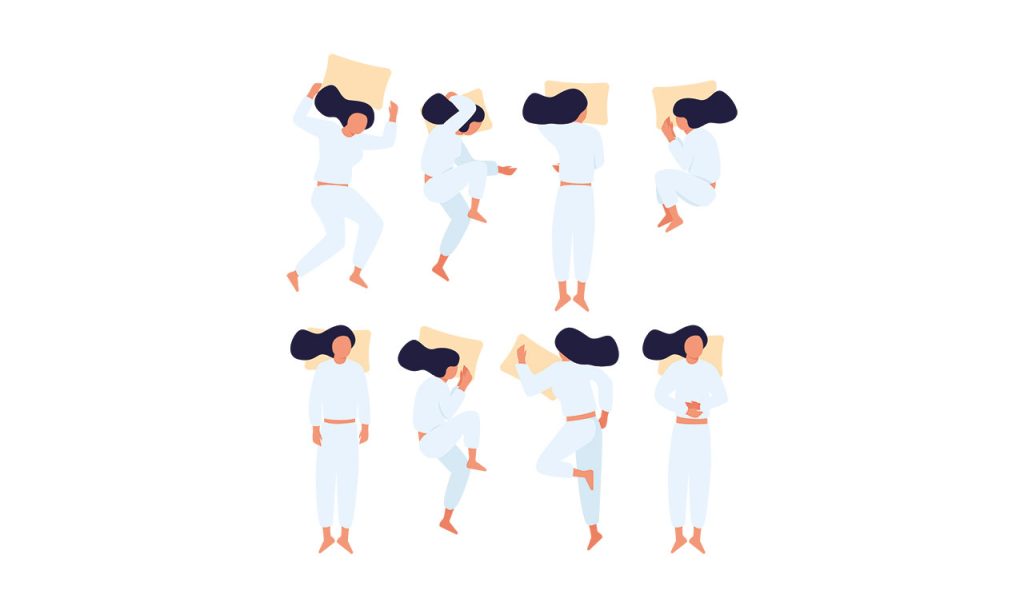
As different as we all are, so are our sleeping habits. Some sleep a lot, others a little. Some love to sleep with the window open, while others need their bedroom to be cosy and warm. The position in which we sleep also varies from person to person. There are, of course, classic stomach sleepers, side sleepers and back sleepers. However, these three categories can also be further subdivided depending on how the arms, legs and head are placed next to or on top of the body in the respective sleeping position.
Here at billerbeck, your sleep experts, you can find out which positions people like to adopt when sleeping and what amusing names these positions sometimes have.
Sleeping position: Embryo
Sleeping like a baby. The embryo position is actually called this because it is reminiscent of the position that foetuses adopt in their mother’s womb. In this widespread sleeping position, you sleep on your side. The legs are bent and pulled up to the chest. The arms are also positioned close to the body, usually in front of it. In some cases, one arm is hidden under a pillow. Many people find this curled up, almost spherical sleeping position extremely comfortable and cosy.
Sleeping position: Tree trunk or candle
Both terms perfectly capture the essence of this sleeping position. The sleeper lies straight and stretched out on their side like a tree trunk or a candle. The legs are close together. The arms are usually placed at the side on or under the body, sometimes a hand is also positioned under the pillow. The tree trunk or candle position is also one of the most popular sleeping positions. Our tip: If you suffer from heartburn, it is best to lie on the left side of your body. Due to the natural position of the organs, reflux occurs much less frequently than when lying on the right side.
Sleeping position: Melancholic or longing
The melancholic or longing sleeping position is similar to the tree trunk or candle position. The basic posture is identical in both positions. The sleeper lies on their side with their legs stretched out and close together. In rare cases, the legs are also positioned at a slight angle. However, the arms are not placed close to the body in the melancholic or longing sleeping position, but are stretched out forwards. This makes it appear as if the sleeper is stretching their upper limbs towards something or someone, almost as if they want to reach for it.
Sleeping position: Soldier
This somewhat martial-sounding sleeping position is actually quite harmless. So don’t worry! The soldier position is the sleeping position in which you sleep straight and stretched out on your back. Arms and legs are also stretched out. The arms lie close to the sides of the body. This position is remotely reminiscent of a soldier standing at attention, which is where the name of this sleeping position comes from. Even though the soldier position is very good for the back, if you tend to snore, you should adopt a different sleeping position for the sake of your fellow sleepers. The soldier sleeping position is particularly good for snoring.
Sleeping position: Free fall
By this we don’t mean the wincing that can sometimes occur when falling asleep if you feel like you’re about to plummet. There is also a sleeping position called free fall. This name comes from the fact that the position resembles a parachutist in free fall a few seconds after jumping out of an aeroplane. Lying on the stomach, legs stretched out straight and arms bent upwards. The head is on one side. The hands are positioned next to or under the pillow. When sleeping in this position, it is important to ensure that the mattress and pillow are suitable for stomach sleepers, as otherwise this can lead to tension and pain in the back, neck or shoulder area.
Sleeping position: Star or starfish
This posture already seems very appealing by name. If you sleep in the star or starfish position, you lie on your back. The arms and legs are stretched out straight. The legs are spread apart and the arms stick out to the side of the body – almost like the points of a star or the arms of a starfish.
Sleeping position: Mummy
Whether stretched out on your back or on your side, if you prefer to sleep with the duvet wrapped around your body almost like a sleeping bag, you are sleeping in the mummy position. This sleeping position is a variation of the tree trunk and soldier positions.
Sleeping position: Flamingo
The flamingo position doesn’t use any pink at all. In this sleeping position, you lie on your side. One leg is stretched out straight, while the other is bent and pulled towards the body, reminiscent of the typical posture of a flamingo standing on one leg. This variation can be seen as a hybrid of the embryo and tree trunk position.
Sleeping position: Sphinx
The sphinx position is particularly popular with children. Here they sleep on their stomach with their legs bent under their body and pulled up. The hands are also close to the body and are placed either under the pillow or directly in front of the chest. You could say that the sphinx is an embryo position turned onto the stomach. In varying degrees of intensity, the sphinx position is sometimes very compact, so that the sleeping child appears almost like a curled-up package. Sometimes it is more relaxed, with the buttocks facing the sky and the legs not drawn up directly to the chest.
Our conclusion
Whichever sleeping position you adopt, it is important for restful and healthy sleep that you have the right bedding for every sleeping position. That’s why we offer numerous different mattresses, toppers, pillows and pillows for stomach sleepers, side sleepers and back sleepers, so that we can meet the individual sleeping needs of each of our customers. After all, it’s not for nothing that a good day begins at night.














